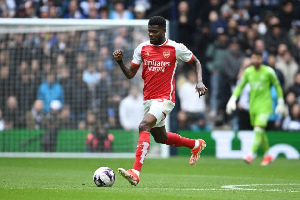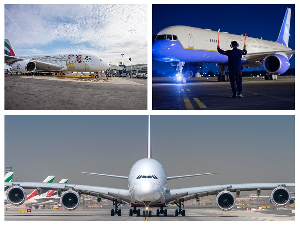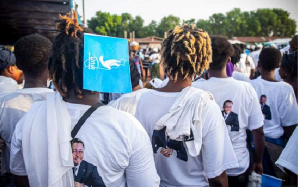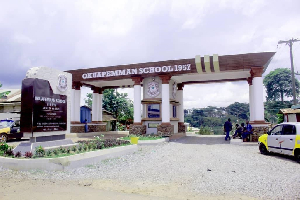- Home - News
- TWI News | TV
- Polls
- Year In Review
- News Archive
- Crime & Punishment
- Politics
- Regional
- Editorial
- Health
- Ghanaians Abroad
- Tabloid
- Africa
- Religion
- Election 2020
- Coronavirus
- News Videos | TV
- Photo Archives
- News Headlines
- Press Release
Business News of Friday, 22 June 2007
Source: GNA
World Bank Board approves landmark assistance strategy for Ghana
Accra, June 22, GNA - The World Bank said on Thursday that its country program would support Ghana in implementing the Growth and Poverty Reduction Strategy (GPRS II) to achieve a middle-income status and ensure that the benefits of the growth are shared.
A statement from the Bank receive in Accra on Friday said the Board of Executive Directors of the World Bank has discussed its new Country Program for Ghana, representing US$1.3 billion for new operations based on the Ghana Joint Assistance Strategy (G-JAS) signed by 16 partners. It said the Board also approved two projects, an Urban Transport Project financed by an IDA Credit of US$45 million and a Global Environment Facility (GEF) grant of US$7 million, and an additional financing of the Internatiolnal Development Association (IDA) to the tune of US$10 million for the Small Towns Water Supply and Sanitation Project. Under the previous Country Assistance Strategy, Ghana exceeded its two overarching objectives, raising its GDP from an average five per cent over the past two decades to an average six per cent during 2004-06.
According to a recent Ghana Living Standard Survey (GLSS) report release by the Ghana Statistical Service, poverty indicators also show a remarkable improvement, down to 28.5 per cent in 2005/2006, from 39.5 per cent in 1998 and 51.7 per cent in 1991. "This puts Ghana in the lead of its African peers as it positions itself to become the first nation to achieve - ahead of schedule- the poverty MDG of halving poverty by 2015," the World Bank said.
The three overarching objectives of the World Bank Program with Ghana are to sustain economic growth of at least six per cent per year, surpass the millennium development goal of halving poverty to 26 per cent and start to reduce inequalities. The World Bank Program was presented to the Board, along with the G-JAS, which seeks to scale up efforts by Ghana and her development partners to adopt a more harmonized and efficient way of working together to implement Ghana's Growth and Poverty Reduction Strategy (GPRS II) and achieve even better results. The statement said a total of 16 partners prepared and signed G-JAS, representing 95% of aid disbursements.
During the four-year implementation period of G-JAS (2007-10), development partners expect to provide about US$5.7 billion to support Ghana's efforts, while the Government of Ghana is planning to provide roughly the same amount for priority development programs over the first three years, according to agreement at the end of Ghana's 14th Consultative Group Meetings which took place in Accra this week. Mr Mats Karlsson, World Bank Country Director for Ghana, in a speech noted: "We now know that economic growth - through the work of a multitude of farmers, women and men and also children, through investment and toil by businessmen and workers in both the informal and formal industrial and service sectors, through a combination of private initiative and public responsibility - has lifted a million people out of poverty between 1999 and 2006.
"Despite continued population increase, the number of people living below Ghana's poverty line is decreasing at an accelerating pace of about 150,000 a year. " Mr Karlsson said Ghana stood to achieve the Millennium Development Goal of halving poverty levels from 1990 already next year in 2008, perhaps first among its peers. However, there still existed a number of bottlenecks to Ghana's further progress- poor infrastructure, problems in the energy and water sectors, as well as the large public sector wage bill. The statement said the Urban Transport Project would improve mobility in areas of participating metropolitan, municipal and district assemblies through a combination of traffic engineering measures, management improvements, regulations of the public transport industry, and implementation of a bus rapid transit system. "It will help decrease peak-hour public transport vehicle flows and make better use of road space and promote a shift to more environmentally sustainable urban transport modes and encourage lower transport-related greenhouse gas (GHG) emissions along the pilot bus rapid transit (BRT) corridor in Accra."
It said Agence Fran=E7aise de D=E9veloppement (AFD) would contribute US$20 million equivalent to finance project activities and the Government of Ghana has committed to contribute US$18 million. The Small Towns Water Supply and Sanitation Project is the Second Phase of the Community Water and Sanitation program to increase access to small towns water supply and sanitation services in six regions and provide 500,000 people with water supply facilities, and 50,000 people with sanitary facilities. "The additional financing credit which was just approved will enable the completion of original project activities in view of unanticipated cost overruns arising from higher unit costs," the statement said. "These increased costs resulted from a larger share of towns with small population sizes than expected. The proposed additional financing will thus deepen the development benefits and strengthen the sustainability of the final phase of this two-phase Community Water and Sanitation Program Adaptable Program Lending."










